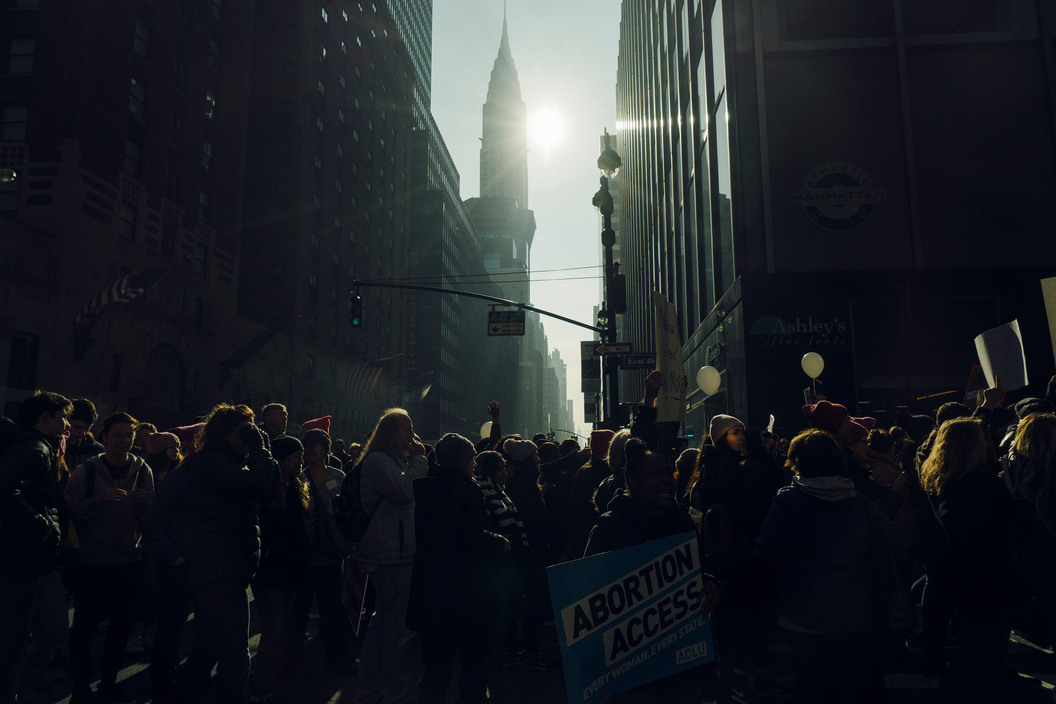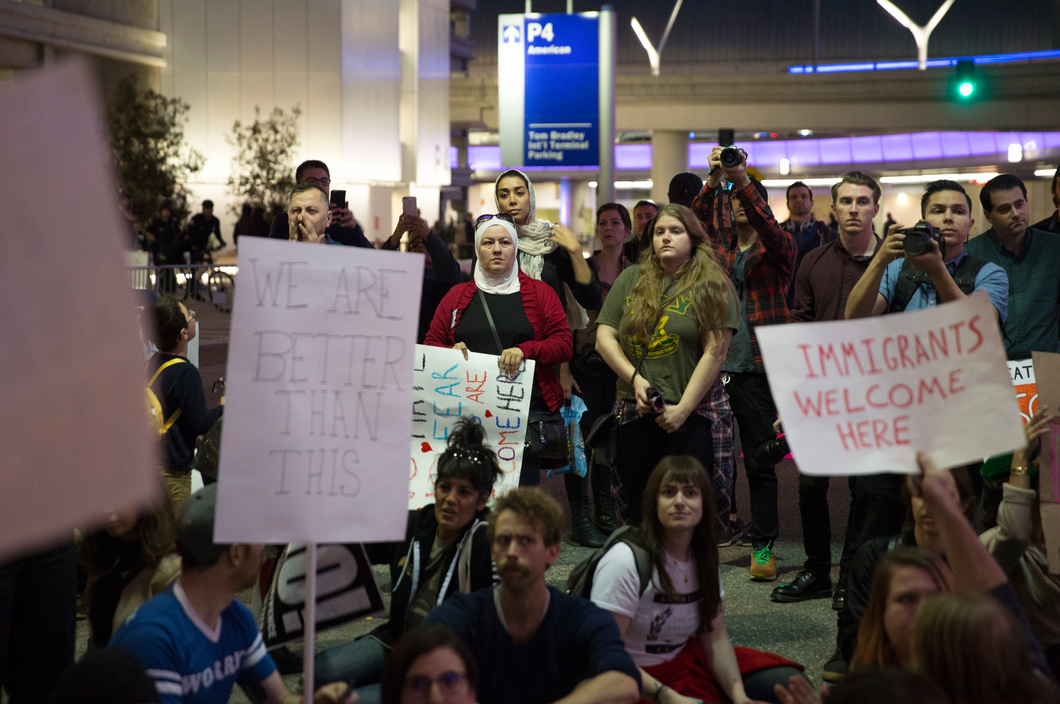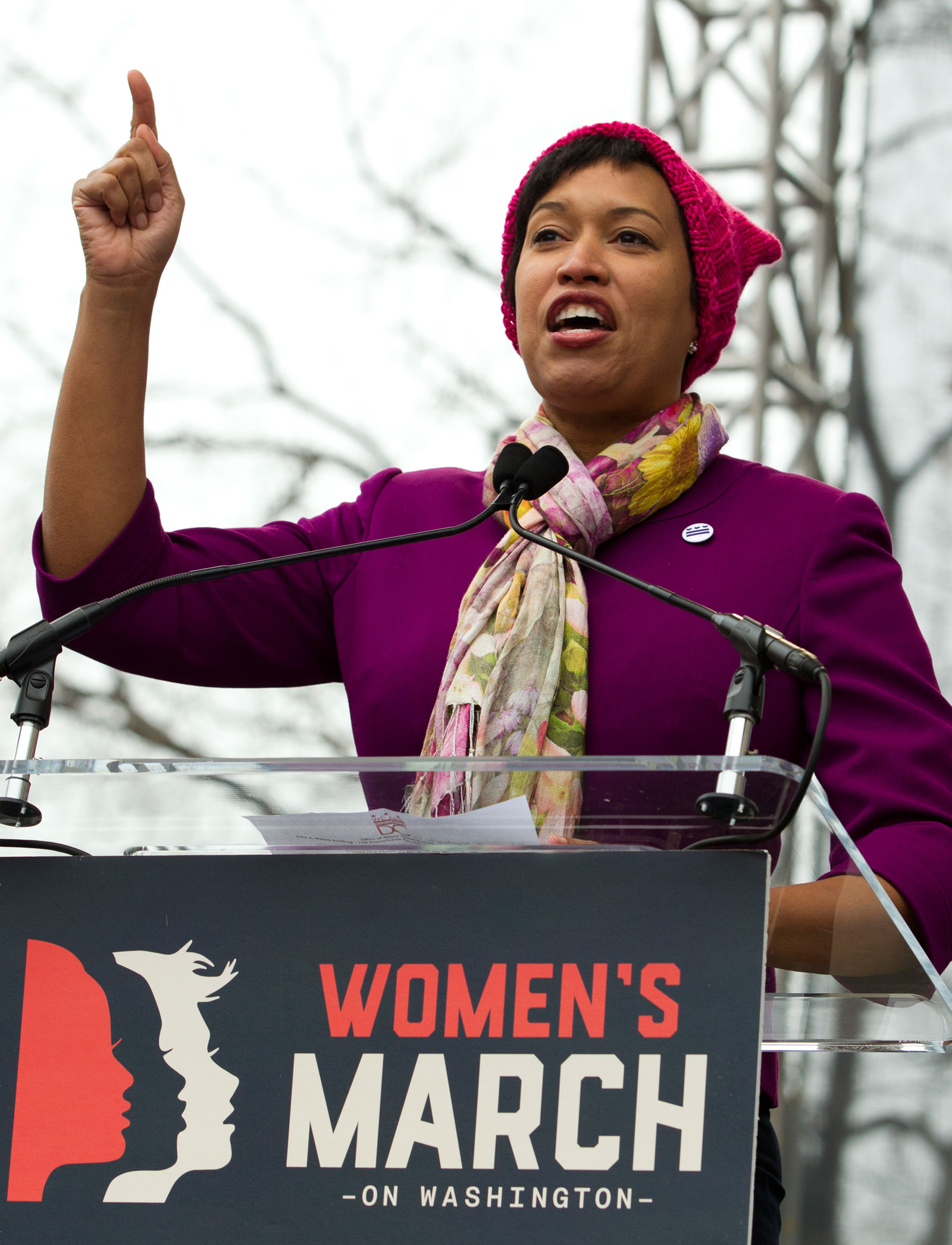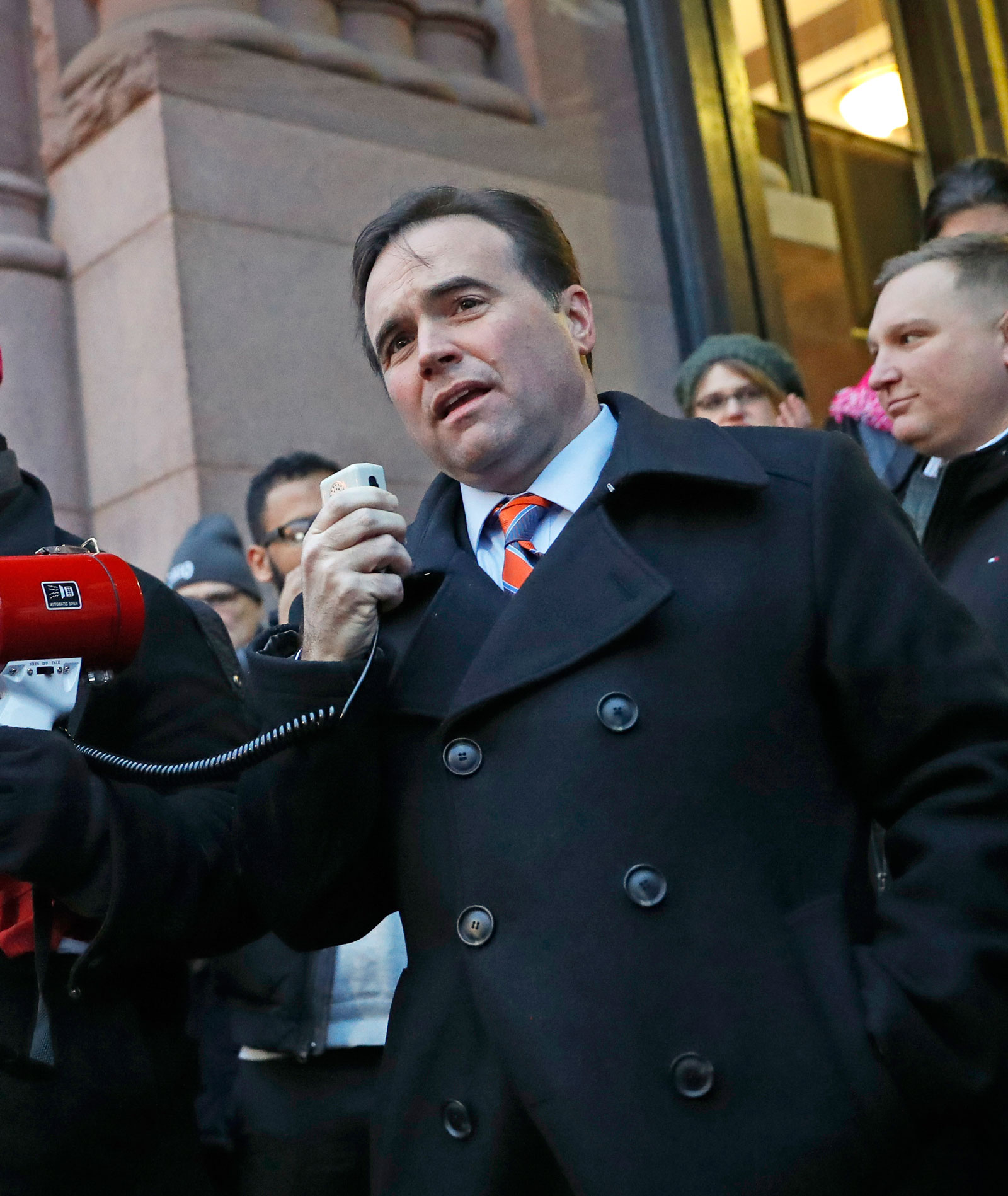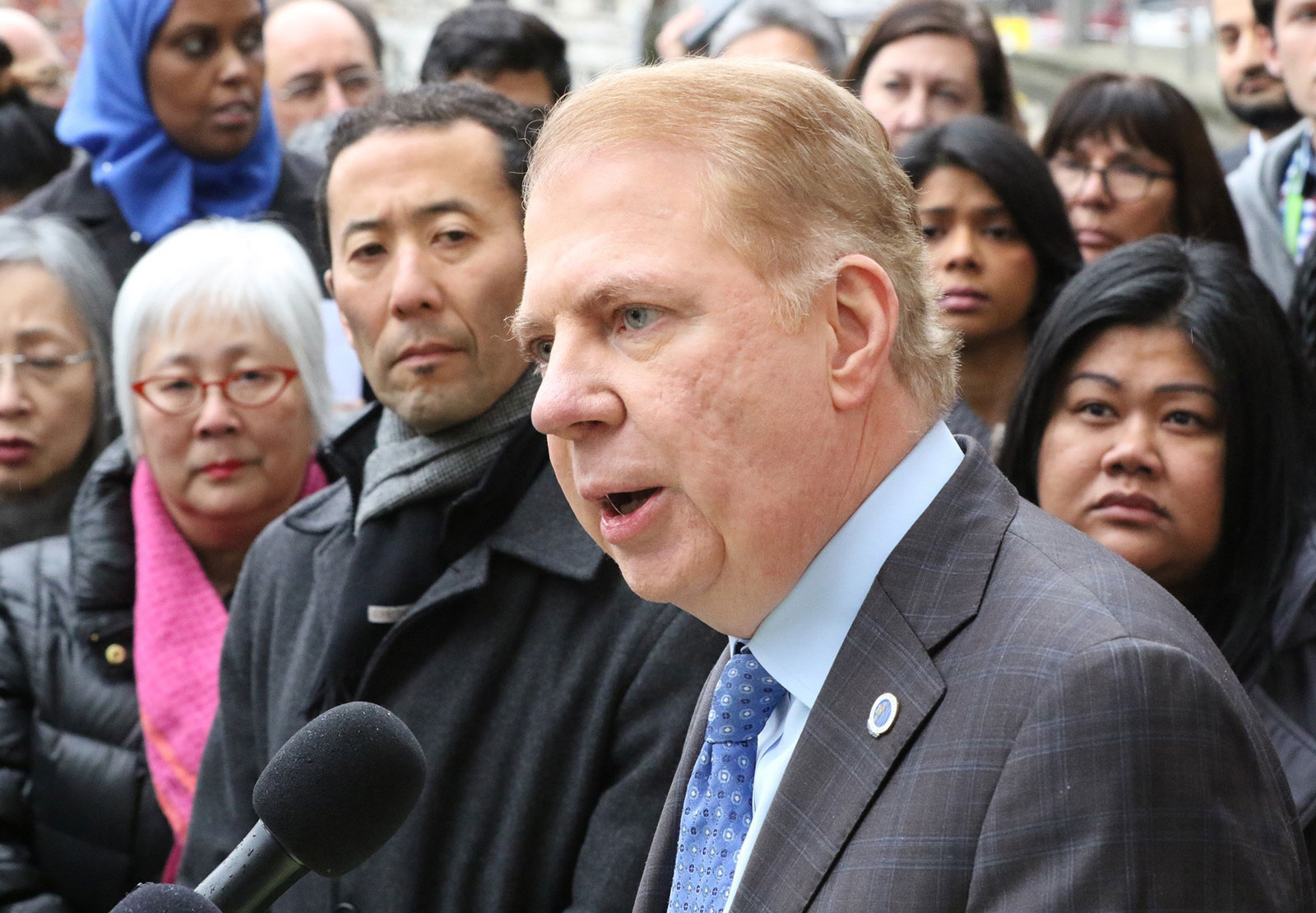The first weeks of the Trump administration have felt at times like the onset of a kind of cold civil war. The spontaneous surge of protest that has marked much of the country’s response to the new president seems fueled not only by his policies, but by the aura of eager cruelty emanating from the White House and a collective intuition that a severe threat to the country, and to the world, is at hand.
For a similar explosion of disaffection one has to go back half a century, to the Vietnam War. But it took time for the anti-war protests to gain the support of a wide array of prominent officials—some members of Congress opposed the war, but the McGovern-Hatfield Resolution to require the withdrawal of US military forces from Vietnam wasn’t introduced in the Senate until 1970, after years of mass protests. It was defeated by a vote of 55 to 39. By contrast, the opposition to Trump’s policies from a broad range of present and former elected officials has been immediate and, for the moment at least, appears to be spurred on by, and in visceral agreement with, protesters on the street.
By way of comparison, think of the demonstrations of 2003, during the run-up to the invasion of Iraq, when the Bush administration’s use of alternative facts to muster public support was at its most blatant. On January 18, 2003, 300,000 protesters gathered in Washington, enraged by false reports about Saddam Hussein’s military capabilities and warning of catastrophe if the invasion were to occur. A month later, millions took to the streets with the same message in Europe and around the world. In the US, the protests received virtually no support from elected representatives and were dismissed by most news outlets as knee-jerk pacifism and therefore inconsequential; while the administration’s bogus case for war was given extensive airing in The New York Times and other leading news organizations.
Everything about the present moment feels different. On January 21, the day after Trump’s inauguration, the Women’s March, which began as a lone suggestion on Facebook, had swelled into a nation-wide expression of revulsion for the extremist views of the new president and his closest advisers and cabinet nominees.
In New York that day, one of the first things I noticed was the relaxed and, in many instances, openly supportive attitude of the police. There were very few officers in helmets and riot gear standing at menacing attention along the barricades. Instead, cops were clustered offstage, as it were, far enough away from the demonstration to be more like bystanders, ready to intervene, if needed. The police who were visible along the route of the march were mostly weaponless members of the NYPD’s Community Affairs Bureau.
This had a profound psychological effect, creating an atmosphere of sympathy between demonstrators and local government, as if what was being presented on the streets was a united counterforce to the new regime in Washington. Some marchers were noticeably taken aback, and delighted, by the friendliness. One female officer had a pair of pink handcuffs hanging from her belt. Others were flirty, helpful, allowing protesters to flow freely on either side of the barricades. How different this was from the police tactic—used at Zuccotti Park and more recently in response to the Black Live Matters “die-ins”—of corralling demonstrators into tight, penned-in spaces from which they feel desperate to escape and disperse. And how different from the behavior of the NYPD during the Republican National Convention in 2004. Then, peaceful protesters against the Iraq War were arrested en masse and held without arraignment at a makeshift detention center at a Hudson River pier for as long as three days, forced to sleep on the floor. (In January 2014, a court ordered the city to pay $17.9 million for violating the civil rights of those protesters.)
No wonder some of the people I talked to at the Women’s March were experiencing a sort of Pavlovian pessimism about the effectiveness of their presence. Marchers on January 21 seemed to carry, more than anything else, a knot of impotent anxiety—and fear—that had been growing since the election in November. Ten weeks of stunned, isolated screen-staring at the news seemed to demand some kind of release—and release was momentarily provided in the form of whooping primal battle cries that occasionally rushed through the crowd like a sonic wave.
The signals of solidarity between local government and protesters would take time to sink in. But six days later, on January 27, it did sink in: outrage at Trump’s late-Friday-afternoon executive order temporarily banning immigrants—as well as travelers with legal visas and even green-card holders returning home—from seven predominately Muslim countries had the feeling of a fully-fledged opposition movement. The order also imposed an indefinite ban on Syrians that appeared to be specifically aimed at war refugees who already had been granted asylum in the United States.
Advertisement
In New York, the world’s emblematic immigrant city (and one with a population of some 800,000 Muslims), the highest elected officials were quick to support protesters who had made their way, within hours of the order, to John F. Kennedy Airport. On Saturday, January 28, Governor Andrew Cuomo ordered the Port Authority to reverse its decision to bar demonstrators from boarding the AirTrain to JFK, where they sought to join others already at the major arrivals terminals. “The people of New York will have their voices heard,” Cuomo wrote at the end of the order. Within fifteen minutes of its issuance the AirTrain doors were opened to all.
The following day, at a hastily organized rally in Battery Park, all three of New York’s citywide elected officials—the mayor, the comptroller, and the public advocate, as well as the Senate minority leader, Chuck Schumer—delivered emotional speeches against Trump’s immigrant ban. The rally was followed by a march through downtown New York to the plaza in front of the federal court house in Foley Square. The ban was an attack on America’s very idea of itself, the speeches at Battery Park went, an attack on one of its most sacred foundational ideals. “Irish Need Not Apply: We’re Immigrants Too” read a typical sign. An eleven-year-old boy brandished a cardboard square with the words, “Grandson Of A Refugee.” “This Muslim Believes That Barney Greengrass Is The Best Deli In NYC And Martinis Should Never Be Shaken,” read another sign. Parents could be heard explaining to their young children the distinction between being an immigrant, an exile, and a refugee. In a striking tableau, a man clad as an expressionist papier mache Trump—a Max Beckmann Trump—held a fake bald eagle in a cage in one hand, while manacled to his other hand was a dark-complected woman dressed in black, stretching her body into a posture of enslaved persecution: the refugee incarnate.
That the travel ban was issued on Holocaust Remembrance Day—with its memories of European Jews being denied sanctuary in America in the face of extermination—seemed to compound the offense. When it emerged that the White House had deliberately omitted any mention of Jews in its official, tepid acknowledgement of the Holocaust, the sheer maliciousness of the order was highlighted even further. To paraphrase Willem De Kooning, the present seemed to be influencing the past—in a chilling manner.
In Battery Park the afternoon was clear enough for Ellis Island to be visible in the harbor, and Mayor de Blasio, speaking to the crowd (estimated at 15,000) made the point that 40 percent of Americans, himself included, can trace their origins to the twelve million who gained entry to the United States through that tiny spit of land. “We have never seen such a brazen and open and immediate attempt by a president to undermine our Constitution,” he said.
He seemed to be forgetting the Immigration Act of 1924, the first successful large-scale attempt to restrict immigration into the United States. Signed into law by President Calvin Coolidge, it is the legislation closest in spirit to Trump’s executive order. It established strict quotas for the number of immigrants from Eastern Europe. In addition, it severely restricted the number of immigrants from Africa and placed an outright ban on “Asiatics and their descendants,” as the bill put it, which was especially aimed to keep out people from India. (The Chinese had already been banned.) The reasons for the act were explicitly racial: its supporters in Congress worried aloud about the weakening of America’s “superior” Protestant strain; and Senator Reed, a sponsor of the act, explained that it was designed to “keep American stock up to the highest standard.”
The East European quotas were tailored to restrict Jews, who were deemed to be deranged terrorists and Bolsheviks, and Slavs, who were deemed to be genetically inferior. Trade union leaders, fearing a drop in wages as a result of a surplus of foreign workers, supported the act. The number of Jews admitted to the US decreased from an average of about 50,000 per year between 1880 and 1924 to fewer than 10,000; the number of Polish immigrants dropped from 95,000 to 10,000. The act encouraged (non-Jewish) immigration from Germany and Britain, which duly increased after it became law. The quotas remained in place, for the most part, until 1965.
With his keen attunement to America’s xenophobic and White nationalist strains, Stephen Bannon, Trump’s chief political strategist, may see the current executive order as the opening salvo in a broader plan to build upon the precedence of the 1924 act and tighten restrictions on immigration further. In a radio interview with Bannon in 2015, Jeff Sessions, Trump’s nominee for Attorney General, spoke of the 1924 act with admiration and appeared to imply that he would like to see some form of it come back.
Advertisement
What was different in 1924 was that there was almost no opposition from elected officials—only nine dissenting votes in the Senate and very few in the House. Today, defiance of Trump’s order includes a multitude of politicians, bureaucrats, judges, and citizens. The mayors of the country’s largest cities have led the opposition. Mayors have their own executive power. They make and enforce municipal laws, and preside over extensive infrastructure, housing issues, public employees and budgets. They also appoint police chiefs, and an impressive number have made it clear that they will not allow their law enforcement officers to comply with any future federal order to harass or round up undocumented immigrants for deportation. Speaking in support of protesters at Dallas/Fort Worth Airport on January 28, Dallas mayor Mike Rawlings called Trump’s immigration ban “a foul insult to the rest of the country.” In a pained incredulous voice, he added, “Dallas is not this sort of city.
During the weekend following the ban, protests erupted in Atlanta, Chicago, Seattle, Philadelphia, Boston, Washington, D.C., Minneapolis, San Francisco, Denver, Houston, Detroit, Los Angeles—thirty cities in all. Mayors Eric Garcetti of Los Angeles and Ed Murray of Seattle have the support of their governors in standing up for their immigrants, but opposition to Trump’s order from Megan Barry of Nashville and Greg Fischer of Louisville, Democratic mayors in staunchly Republican states, shows the stark political split between municipalities and the suburbs and rural districts that surround them. In Minneapolis a protester dragged a cross on her back with the words, “Jesus Was A Refugee,” and a significant number of Christian groups have condemned the ban.
Members of Congress report that their phone lines have been jammed with calls. And not only about the immigration ban: in record numbers citizens have been pushing elected officials to stand up to threats to the nation’s public school system posed by the new education secretary, threats to the environment from Trump’s climate-change-denying EPA nominee, the administration’s plans to dismantle the civil rights division at the Justice Department, repeal the Affordable Care Act, and declaw the regulations of the Dodd-Frank Act that were put into place after the 2008 financial crash. A man told me he’d dialed Senator Schumer’s office ninety-two times without reaching an actual person. He wanted to tell Schumer to stop voting for the confirmation of Trump’s cabinet nominees. “I finally gave up and joined a group of people shouting outside the senator’s apartment building on Eastern Parkway instead.”
There’s little doubt that the popular outcry has emboldened public officials to take action. Acting Attorney General Sally Yates’s announcement on January 30 that she would instruct Justice Department lawyers not to argue in favor of Trump’s order because it targeted Muslims seemed at least in part to be inspired by the protests. (Yates, an Obama appointee, was fired hours after she made the announcement.) The same appeared to be true of the hundred State Department employees who signed a Memo of Dissent over the order on the grounds that denying visas “to over 200 million legitimate travelers” would undermine international alliances and “not achieve its aim of making our country safer.” A day after Trump’s press secretary, Sean Spicer, invited the dissenting employees to get with the program or “get out,” nine hundred more signed the memo, bringing the total to one thousand. It was remarkable to see career diplomats, a group not known for its boldness, willing to be sacked or blackballed within their department in order to publically express their concerns.
Demonstrators had gathered within earshot of a federal judge’s courtroom in Brooklyn on January 28 when she issued the first stay to Trump’s order. Within twenty-four hours, three more judges made similar rulings. Five days later, after a judge in Boston upheld parts of the president’s order, a judge in Seattle, James Robart, who had been appointed by President George W. Bush, signed the most sweeping ruling against it yet. The plaintiff’s brief was presented not by the ACLU but by the state’s solicitor general, with the blessing of Washington’s governor Jay Inslee. (The state of Minnesota later added its name to the brief, and fifteen states filed a supporting brief maintaining that the ban would harm their local economies and institutions.)
In a historical somersault, the federalist assertion of state rights—for decades the constitutional tool of segregationists and social conservatives—was now being invoked by the left to protect itself against an over-reaching president. Washington state, the solicitor general argued, would be hurt in the form of lost taxes, employment, and families in distress if lawful visa holders and returning residents were to be barred. “Federal courts have no more sacred role than protecting marginalized groups against irrational, discriminatory conduct,” the brief said. Judge Robart agreed, adding that the president’s order had failed to show that the banned travelers posed a threat to the country.
On Tuesday afternoon, the case went before the Court of Appeals for the Ninth Circuit in San Francisco, which had received an Amicus brief against the ban from nearly 130 tech companies, among them Apple, Google, Facebook, Microsoft, Uber, and Tesla. A ruling will probably be rendered before the end of the week, but the case, which essentially revolves around the question of whether the president has the power to arbitrarily change the country’s border policies regardless of the damage it may cause, appears to be headed to the Supreme Court.
This is the first of what will surely be a number of critical confrontations between the Trump administration and the other branches of government. A lot of damage will be done by this president. But the range of opposing forces taking shape shows signs of being effective. Hundreds of thousands of people have already pledged support for a scientists’ march on Washington on April 22, Earth Day. More demonstrations are likely to materialize.
The streets and public spaces of the country’s cities are where protesters are most seen and heard. Mayors, and in many cases governors, seem to be telling their citizens, in a way rarely, if ever, seen in our recent history, that the public spaces are theirs. It appears to be a potent alliance. At least for now.


